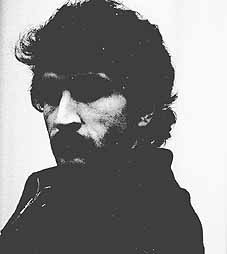 Several
years ago, I found a small strip of 35 mm film on the sidewalk of Kalajeva
Street in Leningrad. Evidently torn from a larger series of pic-tures,
it was at one time, perhaps, a piece of a motion picture. The industrial
logo spelled out in Cyrillic by the sprocket holes suggested to me that
both the film and the scene it depicted were Soviet in origin, and not
the litter of Western tourists. Each of the three frames contained
on the film showed the same picture: a man dressed in a long coat and a
cap standing between a wooden fence and a body of water. The fence encloses
a dense, wooded vegetation, which frames one side of the image. The man
stands at the center of the photograph, looking away from the camera toward
the water. Between the fence and the water, the plot of ground on which
the man stands is grassy and well maintained. Three tall, rough hewn poles
form a descending line into the distance of the landscape. Near the most
distant pole, a road emerges from the wood and slopes into the water.
Several
years ago, I found a small strip of 35 mm film on the sidewalk of Kalajeva
Street in Leningrad. Evidently torn from a larger series of pic-tures,
it was at one time, perhaps, a piece of a motion picture. The industrial
logo spelled out in Cyrillic by the sprocket holes suggested to me that
both the film and the scene it depicted were Soviet in origin, and not
the litter of Western tourists. Each of the three frames contained
on the film showed the same picture: a man dressed in a long coat and a
cap standing between a wooden fence and a body of water. The fence encloses
a dense, wooded vegetation, which frames one side of the image. The man
stands at the center of the photograph, looking away from the camera toward
the water. Between the fence and the water, the plot of ground on which
the man stands is grassy and well maintained. Three tall, rough hewn poles
form a descending line into the distance of the landscape. Near the most
distant pole, a road emerges from the wood and slopes into the water.
Throughout its brief history photography has been presented as a universal language. Photographs of men and women in various conditions of health and sickness, wealth and poverty, community and solitude, have been used to represent the commonality of experience, the relatedness of all to one and of one to all. Yet as I look at this small picture I am aware that whatever shreds of meaning I am able to obtain from it emerge from within myself, from my own history as a “reader” of photographic images, rather than from the meaningful intentions of its author.
This photograph, which was at one moment deemed worthy of preservation, and at another torn from its source and rejected, fascinates me. Abandoned by its author, the image has come into the presence of a reader (myself) who seeks, through recognition of familiar signs (water, fence, telegraph poles, road), to establish a text sufficient to discover its meaning. Absent an authoritative text to tie them together, however, the signs I am capable of distinguishing fail to form a linear narrative; they do not “line up” to tell a story. Without an author to “close” it, the history of the photograph is indeterminate. Its text is open to my interpretation.
Given that we are rarely familiar with the intentions of the authors of images that everywhere surround us, how is it possible that we ever obtain meaning from photographs? More often than not, the photographer will have executed his or her pictures to fit within internationally recognizable aesthetic categories, or genre, such as landscape, documentary, or portraiture. If the photographs that we are viewing function outside such categorization, we may look for meaning by studying the culture from which the photographs have emerged. Finally, viewers may rely on the photographer (or on a critic) to provide a text locating the aesthetic, institutional, or cultural significance of the pictures. In each of these methods for interpretation meaning is determined through narratives that exist outside the immediate relationship of the viewer to the photographic image. Each depends upon an outside authority to construct meaning through a closed or fixed text.
In authoritarian regimes, the state is the ultimate author of all texts. The state exercises its authority through absolute control not only of the artist, but also of the viewer. The state controls not only cultural institutions, such as museums, but also the material that those institutions may present and the media within which such presentations may be discussed. The state controls not only the creation of images, but also their circulation and their destruction. In other words, the authoritarian state controls the words, the images, and the media through which its historical record is created, maintained, and preserved. The state’s absolute control of the image confers upon it a “theological” closure, such that the image is closed to interpretation. This closure is the root of the ideological value of the photographic image in authoritarian states.
Images emerging from totalitarianism may be understood only through the closed or ideological “text” of state control. Appearing to allow the viewer no role in the construction of meaning, the authoritarian text implies a natural and exclusive bond between image and state. The relationship of the photographic image to time (that the event photographed has truly occurred is proven by its presence in the picture) extends, on the two-dimensional surface of the photographic print, to the state. Thus, the state is endowed with the look of history. The relationship of the viewer to the history depicted in the photograph is determined by his or her acceptance of its underlying text of control.
Photographic images emerging from totalitarianism, yet unauthorized by the text of state control, are indeterminate; they are incapable of possessing absolute meaning. Such images possess no fixed text determining their origins or intentions. Unauthorized (or, as they have come to be known, “unofficial”) images engage viewers in the open-ended construction of meaning through the absence of such a text. Unauthorized photographs represent the challenge of meaninglessness to overdetermination. Refuting the state’s absolute control over cultural signification, such images position viewers within a relationship of resistance to the concept of the author, and thus to the authority of the state. Such images need not be “political,” but they are always “active.” In the unauthorized images that come to us from authoritarian cultures, therefore, meaning may be determined as much through the activity that they promote as through the collection of signs that they represent.
The particularly subversive quality of the photographic image, as appealing to the artist working against state control as it is provocative to the state seeking to control it, is its position as both an artwork and a document. The photograph stands, simultaneously, both inside and outside of time. What we experience when we look at a photograph, as John Tagg has noted, is
a double movement which typifies ideological discourse. On the one hand, the ideological construction put on the objects and events concretises a general mythical scheme by incorporating in it the reality of these specific historical moments. At the same time, however, the very conjuncture of the objects and events and the mythical scheme dehistoricises the same objects and events by displacing the ideological connection to the archetypal level of the natural and universal in order to conceal its specifically ideological nature. What the mythic schema gains in concreteness is paid for by a loss of historical specificity on the part of the objects and events. (1)
When a photograph is authorized by the state, levels of meaning appear to merge within it, absolutely and seamlessly, to form an ideological text. However, ideology cannot exist independently within the image, but depends upon the viewer to “activate” it. The ideological function of the photographic is contingent upon the viewer’s a priori acceptance of, or faith in, the image’s cultural signification, as determined “theologically” by the state. The absolution of the authoritarian state is validated by the viewer’s unquestioning faith.
The medium of photography has proved a
fertile ground for artists whose work resists the authority of the text.
Those who produce photographic images within authoritarian states often
use the medium to disrupt ideological discourse. In so doing, they disrupt
the apparent relationship of the state to time and to history. They profane
the natural order, showing, to paraphrase Roland Barthes, that a text is
not a line of signs releasing a single “theological” (or, as Tagg would
have it, “universal”) meaning, but “a tissue of quotations drawn from innumerable
centres of culture,” (2) none of them original, none of them absolute.
It is for this reason that artists working within authoritarian regimes
are often prohibited from producing photographs that do not bear the authorization
of the state.
2.
By [the end of the 1970s] only a few artists remained to be categorized as “prohibited,” only those “impenitent recalcitrans” [sic] like… Tibor Hajas… who, at times deliberately challenging authority, refused to acknowledge any taboos clad in the costumes of politics or morality... It was only the “recalcitrans” who stuck out from the peaceful general view. (3)
In the catalogue accompanying a survey of Hungarian art from 1975-1980, Péter Kovács, Director of the István Király Múzeum in Székesfehérvár has noted that “the ‘avant-garde’ [of that era] had a rest and seemed to peacefully settle down: it turned main stream.” (4) To “turn main stream,” however, implies not only that the avant-garde had, by the mid 1970s, accepted the Hungarian state, but also that the state had accepted the avant-garde. It is significant that this statement, summing up a period in the artistic history of a nation as one of general contentment, comes to us from one of that nation’s important cultural institutions. Other texts from the same period tell the story from a somewhat different perspective.
It was during the late 1970s that Tibor Hajas created his most mature and important works, a series of actions performed for photography. Formally, Hajas’ actions followed the lead of the Viennese Actionism. Working in Austria since the early 1960s, the work of this group of artists, led (arguably) by Hermann Nitsch, merged theatre with artistic production, replacing language with sensation by “pouring out, spraying, splashing, smashing, tearing up, tearing apart meat, or smearing or soiling something,” (5) activities accompanied by the noise of a “screaming chorus” of woodwinds and percussion instruments. The object of the action was to liberate “accumulated and blocked up psychic energies.” Liberation, therefore, rather than any finished piece, was the object of (especially Hermann Nitsch’s) Actionism.
The resemblance of Hajas’ work to the Viennese Actionists’ does not extend far beyond appearances. In contrast to the psychic liberation advocated by the Vienna group, Hajas’ performances challenged audiences against the danger of moral and intellectual passivity. While the role of the spectator in the Viennese Actionism is basically compliance, (6) Hajas’ audiences are prompted to direct participation. In Dark Flash, a performance held at the Galeria Remont in Warsaw, 1978, Hajas hung from the ceiling by a rope bound to his wrists. In his hands he held a camera. As the blood drained from his hands and cut off his circulation, Hajas photographed his audience until, at last, he passed out. Had his audience not finally cut him down, the artist might have died. His film documents their indecision.
Hajas’ performances are reminiscent of the early work of American artist Chris Burden. The provocative intentions of Dark Flash are remarkably similar to those of Burden’s Back to You, 1974, in which a member of the audience was invited to stick push pins into the artist’s body; of Velvet Water, 1974, during which an audience of art school students watched via video monitor as Burden collapsed after submerging his face in a sink and attempting to breathe water; and of Kunst Kick,1974, when, during the public opening of the Basel Art Fair, Burden had himself kicked down a flight of stairs, two or three steps at a time. The struggle of the audience is not with the pain that the artist inflicts upon himself, but with its complicity in inflicting that pain through failure to prevent it. The struggle of the viewer is that of reader against author, of actor against text. The viewer must go against the grain of the text and put an end to it, or s/he must accept the role of passive compliant. The viewer becomes, simultaneously, both subject and author of the artist’s work.
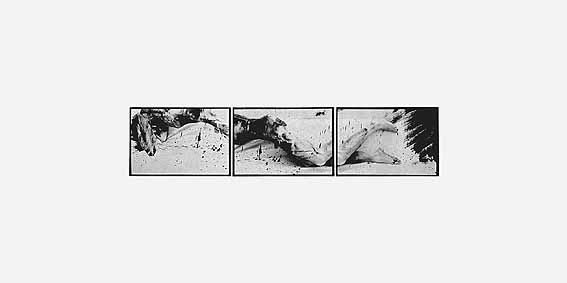
Tibor Hajas: Flesh painting II. (Landscape),
1978
Júlia Szabó has noted that Hajas experienced the element of “hidden risk” in his performances: had the audience not come to his rescue, he might have died. This concept of hidden risk returns us, once again, to the notion of the open, or unauthorized, text. Hajas’ risk extends from his own body to the body of viewers, his audience; the degree of pain that he inflicts upon himself is directly proportionate to his viewers’ acceptance of their authority to end it. As Hajas wrote, “we do not, on our own, deliberately have to do anything to incur damnation; our participation is a prodigal luxury.” (7)
By transforming the role of viewer to participant, and finally to author, Hajas conferred upon viewers the authority to challenge his text. He empowered his audience to take positive action against suffering, to refuse passive complicity. The closed room of the performance space extends to implicate the closed text of the artist, as well as the closed state of authoritarian culture. By acting against the artist’s text, the audience also acts against the text of state culture, “opening” it to interpretation. Within the authoritarian state in which Hajas worked, this was regarded as an act that neither he nor his audience was authorized to commit.
“Censorship,” as writer Miklós Haraszti has noted, “is the final glaze that the state applies to the work of art before approving its release to the public.” (8) Tibor Hajas was “rehabilitated” in 1986, six years after his death, when a small selection of his works exhibited at the Liget Galéria in Budapest failed to arouse official indignation. Following the lead of the Liget, the István Király Múzeum in Székesfehérvár opened a retrospective “memorial exhibition” for Hajas in early 1987. The exhibition Hungarian Art of the Twentieth Century, The End of the Avant-Garde, presented at the István Király Múzeum in 1989, nine years after Hajas’ death, was among the first to present his work within the larger context of the Hungarian avant-garde. In his text for the catalogue of that exhibition, curator Péter Kovács wrote that “even with the really provoking works of... Tibor Hajas challenging accepted values it was rather the thorny behavior than the works’ real or presumed political message that deterred the authority.” (9) Implicit in this statement is the suggestion that although the power of Hajas’ work to provoke is rooted in his audiences’ common acceptance of the values that he challenged, it was his behavior in provoking, rather than the effect of his provocation, that resulted in his prohibition.
Citing Hajas’ attitude rather than his effect, Kovács’ statement reiterates former Politburo member György Aczél’s declaration, made in 1982, that “there is no opposition that has to be reckoned with in Hungary,” (10) only a few maladjusted, untalented, mentally troubled and disappointed people who blame society for their failures. Kovács relegates Hajas to the status of enfant terrible. Hajas’ importance to Hungarian culture of the 1970s, and to the generation of artists working in Hungary today, is sorely diminished by this interpretation. Hajas was more than a “recalcitrant” or “political artist,” butting his head stubbornly against the state. The importance of his work lies not in its power to undermine the values of his audiences, but in its capacity to reinvest those values with meaning. Hajas, like his contemporaries Miklós Erdély and Gábor Bódy, sought to empower his audiences with the authority of moral responsibility. He took his audiences on a journey, similar to that depicted in Miklós Erdély’s photographic series Time Journey I-V,1976, in which viewers were brought face to face with the consequences of their actions.
Using exposures lifted from old family photographs to construct a single self portrait, the third photograph in Erdély’s series, subtitled 1934, depicts the artist at three different stages of his life. Erdély as a boy plays a game of chess with Erdély as a young man, while Erdély as an older man, the artist, observes their game. Erdély the artist knows the nature of the game that the younger men are playing, and he knows which of the two will win.
Time Journey I-V is a complex series of “observations,” of which 1934 stands as the centerpiece. The viewer of the series stands in time with Erdély the artist. In common with the artist, the viewer is a time traveler; s/he observes the artist observing himself. Simultaneously, the viewer is implicitly aware that s/he is observed by the artist. The artist, who created the series for the viewer’s observation, stands between past and future, looking in both directions. Thus, the viewer may observe with the artist, but not without being observed by the artist. This inescapable relationship of observer to observed in which the viewer has been trapped extends telescopically from time past to time future. To know the past is to see the future. Yet to see the future is to deny chance, to cancel the unpredictable. A life denied of chance, a completely predictable life, is but a slave to the certainty of time. A life denied of chance is no longer free.
It is not for freedom itself, total freedom, but for faith in freedom, that Erdély the artist observes Erdély the boy and Erdély the young man playing. This distinction is critical, for it is precisely against freedom through faith (freedom through art, freedom through work, freedom through socialism) that the work of Erdély and Hajas speaks. Such freedom, contingent upon ideology, is false and fleeting. It is as a result of such faith, believing creative expression to be the ultimate act of liberty, that we come to observe the work of these artists. Yet in observing, we are drawn into their trap. The artist locks the door behind us. The artist engages us, demanding that we see that our histories (our family albums) are easily falsified, our beliefs easily corrupted. Our past (the text of history) is our bondage, our truth is our lie. The artist demands that we reject bondage, that we abandon the safety of faith, grounded in ideology, and experience total freedom. (11)
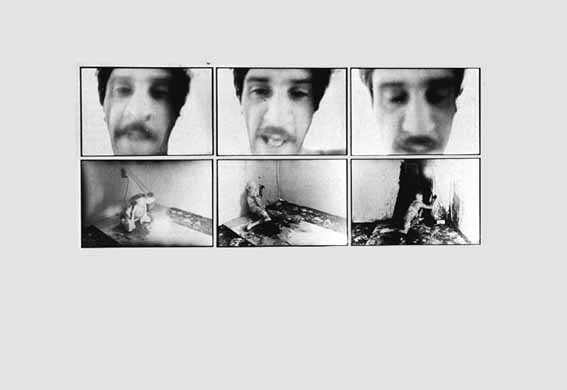
Tibor Hajas: Extinction, 1979
Like Erdély, Hajas placed the concept of total freedom within the grasp of his audiences. That he did so in Hungary in the 1970s insured that he would, more than once, come into conflict with the state. Yet Hajas was not a political artist. Rather, he was an activist (as the term was used to define a tendency in German expressionism) who “reformed [anarchistic impulses] in the direction of neo-enlightenment by elevating psychological revolt to the level of practical and social reform.” (12) Hajas placed ideas above art, and treasured freedom above all.
Touching live wires can cost...lives.
This was something Tibor Hajas knew and wanted and the forbidden touch
brought him its double reward: annihilation and total freedom. Total freedom,
perhaps the most monumental slogan that the avant-garde could conjure up
before the eyes of mankind but which it was, of course, unable to materialize
in socially feasible terms. Tibor Hajas’ influence was thus also condemned
to remain limited but one thing is certain: everyone who met him or was
confronted with his works could not but feel this touch of total freedom.
(13)
3.
I cannot conform to you, I cannot be at your mercy. I have become the guidepost whether you wanted it or not; you can only refer to me, you can only return to me. But it is not necessarily compulsory; we are independent of each other. Don’t let yourself be deceived, my lord. My lord, don’t let yourself be deceived. (14)
In the decade since Hajas’ death Hungarian culture has risen from what appears to Western eyes as a deep slumber. Yet if this was slumber, then the nation’s culture must have been shaken to consciousness by nightmares. Indeed, during the years of Soviet occupation a powerful undercurrent of Hungarian culture has been active in the works of Béla Kondor, Miklós Erdély, Gábor Bódy, Tibor Hajas, and numerous others. Largely unrecognized in the West, these artists have worked, often under duress, to maintain the vitality of Hungarian tradition. Their activities are testament to the will of the Hungarian people, exemplified by the post-World War II election defeats of the Soviet dominated Communist Party, by the revolution of 1956, and by the recent defeat of the Party in the elections of 1990, for self determination.
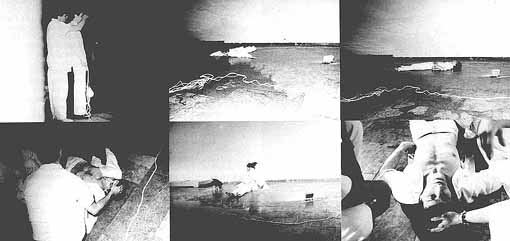
Tibor Hajas: Wake (performance), 1980
Hajas was not alone in his relentless investigation of moral and aesthetic values. Nor was he the only artist to realize his own body as the site of conflict. During the early 1970s, the Squat Theatre, then known as Studio Kassák, began to merge the art of performance with the reality of the audience as a direct result of prohibition. “The place is an apartment on the fifth floor, where we played whatever we wanted to, but the danger played with us...The personal fate, culture and gestures of the spectators became part of the theatre, just like ours. The result: a very selective and subtle communication system, a sort of symbolism based on the realities of this ‘apartment theatre.’” (15) Following the group’s departure from Hungary in 1976, they continued to bring “real life” together with theatre, by performing in a large New York City storefront. “The storefront was a situation where fiction and reality could mix because there was a fiction on stage and there was a real life behind as background, and sometimes the real life intervened.” (16)
“Reality” was also the material of the “experimental” Group Inconnu. “Experimentation, which aims at pointing out to the viewers, more precisely, to the whole of society, the limits of the autonomy of the individual. This is why the field of reality is more appropriate for artistic and social activity, since here the falsity of illusions and substitute gratifications is immediately revealed and the ‘condition humaine’ manifests itself in its own nature.” (17) Throughout the 1970s Group Inconnu merged aesthetic form with political expression using body art, performance, installation, and mail art. The activities of Group Inconnu were consistently prohibited through the 1980s. Toward the end of the decade, the group curtailed its artistic activities to aid the growing number of independent political organizations in Hungary, providing access to printing, telefax, and other services still under state control.
The work of Tibor Hajas is distinguished from that of his contemporaries precisely by its falling between aesthetic and political spheres, into the realm of the personal. Hajas sought to “dispense with my clothes, pastimes, walls, objects and dates that surround me now. To grow as thin as to become mere voice; to lose everything that binds me here now.” (18) Falling into the category defined by Renato Poggioli, in his Theory of the Avant-Garde, as “agonism,” Hajas offered himself as a guidepost for future generations. “In short, agonism means sacrifice and consecration: an hyperbolic passion, a bow bent toward the impossible, a paradoxical and positive form of spiritual defeatism.” (19) (emphasis added) This consecration, Poggioli continues, constitutes “[an] immolation of the self to the art of the future [which] must be understood... as the fatal obligation of the individual artist.” (20) Thus, it is in the work of Hungary’s contemporary artists that we may best observe Hajas’ influence. In the works of Tamás Szentjóby, Ákos Birkás, Bálint Flesch, Antal Jokesz, and others too numerous to mention, Hajas’ contribution to Hungarian culture is directly revealed. Of particular note are János Vető, Zsuzsanna Ujj, and Tibor Várnagy. (21)
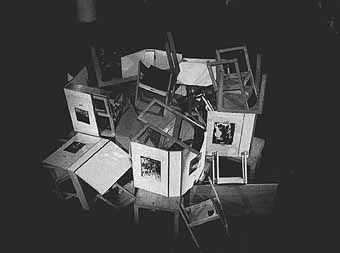
János Vető Installation at Almássy Square, 1989
It is impossible to speak of the work of Tibor Hajas without also speaking of János Vető, his collaborator. It was Vető who worked with Hajas, photographing his private performances for camera, and it is Vető’s sense of space and sequence that imbued these images with an aesthetic drama that parallels the moral and physical drama of Hajas’ actions. In the 1980s, Vető worked extensively as a musician, most notably with the underground “cassette band” Trabant. In his recent photographic work, Vető defies textual interpretation using a layering strategy, apparently merging objects from different images and then partially obliterating them by scratching them out of the negative or by overpainting them in the print. One recent installation of Vető’s work, constructed in 1989 at the Contemporary Art Forum of Almássy Square, presented photographs attached to hinged, book-like binders mounted onto a pile of wooden tables and chairs. The tables and chairs were taken from local schools and culture houses where, not long ago, such work would have met with disapproval. From within this disorderly mound of hard, authoritarian furniture, Vető’s photographs appear to emerge as the new textbooks of Hungarian culture.
Zsuzsanna Ujj is today one of the few Hungarian artists whose work explores simultaneously the mediums of performance and photography. A poet, performer and musician, Ujj’s exhibitions are often accompanied by actions and concerts. In her images, prepared privately for the camera, Ujj is always her own subject. In an untitled series prepared in 1986, Ujj focuses upon the cultural construction of sexuality using a series of poses, alternating between violence and vulnerability, to confront the viewer. Returning the gaze of the viewer, Ujj defies the borders of the print. The anonymous space of the action extends through the print to the space of the gallery and to the viewer within that space. Her photographs transform the tradition of the passive female nude into a site of physical conflict in which the viewer is directly implicated.
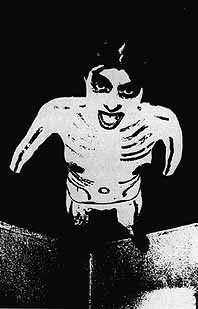
Zsuzsanna Ujj: Untitled, 1986
Ujj’s most recent photographs, a series of sculptural torsos, return to the subject of the female nude. Addressing it from both an aesthetic and a critical perspective, Ujj’s torsos are as formally elegant as they are conceptually disquieting. Using high contrast black and white film to achieve her effect, Ujj’s body, dismembered and devoid of personal detail, emerges dramatically from the black background. The viewer is instantly and pleasantly reminded of countless similar torsos s/he has seen in museums and public places in which the nude female body has been canonized. Yet it is precisely within this pleasant moment of recognition that Ujj’s critique begins. As Kate Linker has written, “identity is constructed only through images acquired from elsewhere.” (22) Identifying the torso, we identify our historical relationship to it, ultimately identifying ourselves by it. Our pleasurable response to Ujj’s torsos implicates us as complicitous partners in the patriarchal construction of female sexuality through visual representation.
The photographs of
Tibor Várnagy, though formally distant from those of Tibor Hajas, continue
the
dialogue with textual authority so prominent
in the work of the latter. Várnagy’s series of TV
Contacts, Fire Prints, and Black Squares
represent an extraordinary investigation of the
photographic image as a message carrier.
Of his work the artist has written,
In 1985 I made my first series of [cameralessl photographs by placing photographic paper on the television screen during broadcasts. Prints made this way lost the photographic sharpness that makes them appear specific or concrete. It seemed that behind the surface of the photographs, where the documentary value is carried, common symbols exist. Later I turned to burning the unexposed photographic paper, developing the remaining surface that had been exposed by its own flame. The resulting images were surprisingly rich formally, in places graphic, and rich in tonal variations. In both series the gesture became significant. I made the black squares in 1988 by illuminating the photographic paper through the empty negative holder. All these may be taken as paraphrases of Malevich, in which the variations are caused by the possibilities of another medium. In contrast to his pieces, I made rectangles because the standard commerically available photographic paper comes in the shape of rectangle: I used these vertically. I found it necessary to overexpose these rectangles, a process that destroyed their geometric movement, introducing the possibility of a new dimension. The ambivalence resulting from this process is positive, or the interpretation of a negative statement; and finally, but not least importantly, the process addresses the issue of multiplicability or the problem of quantity. (23)
Várnagy’s photographs seek to divest objects
of meaning by denying the validity of their cultural functions. This divestiture
extends to implicate the belief that meaning exists independently within
the photograph itself. In his TV Contacts, Várnagy plays simultaneously
with the authority of the artist, using his own initials in the title of
the series, and with the authority of the state controlled television media
from which the images were lifted. The origin of the authoritarian text
has been blurred both in the refusal of the artist to function as a “creator”
(the eye behind the camera) of messages, and in the transformation of the
televised images from rigidly political message carriers to purely formal
objects. Like Hajas, Várnagy reveals by his own action that the authority
of the text (of the state in his TV Contacts, of art history in his Black
Squares, and of the photographic genre and materials in his Fire Prints)
can not exist independently, but depends upon the viewer for its validation
and repetition. The artist is also viewer. Both subject and object, s/he
is at the center of the production of meaning in every text. Only through
the artist/viewer’s active participation in the construction of meaning
is the ideological function of the text subverted, and only through such
subversion is the concept of total freedom within reach.
4.
You could never defend yourselves before, you could never offer assistance, but now this condition bears my name. I am perfectly aware, more so than yourselves, what you stand to lose while you are here. The longer, the more. And a single moment suffices for a catastrophe. I am deliberately taking my time; deliberately holding you up. Holding you up to give catastrophe a better chance. I would like catastrophe to strike you while you are wasting your time here. It would make these moments valuable, significant, set apart, unique. It would give them weight. I could give you the experience of the irremediable. At last you could realize what you are missing. (24)
In the final years of the 1980s, Hungary has been dramatically transformed, politically and culturally. The removal from office of János Kádár, mouthpiece for the Soviet power that crushed the Hungarian Revolution for more than thirty years, has been swiftly followed by the removal of those who sought to replace him. As the borders between Hungary, Austria, and Czechoslovakia have opened, the dictatorship of the Czechoslovak Communist Party has also crumbled, rekindling in the people of the Danubian nations the hope for international unity. Simultaneously, fience nationalist disputes between Central European nations, closed to discussion during the period of Soviet occupation, have been reopened. As Central Europe emerges from domination, the nations of which it is composed have reawakened to the settling of old accounts. The threat of violence, as recent attacks upon the Hungarian minority in Rumania have shown, is all too real.
Although they may not have been aware of it, the work of Hajas and his contemporaries is symptomatic of the earliest movement toward reformation in the nations of the Warsaw Pact. The period in which Hajas worked (the 1970s) is traditionally viewed as the close of the period of thaw following the Khrushchev years. This view of “open” and “closed” periods of artistic expression fails to acknowledge the fact that even in periods of repression artists in Hungary have continued to develop their work independently of the state. The development of independent ideas during the Khrushchev era did not simply end upon his replacement by Brezhnev, but continued by exercising a profound influence upon younger artists, who pursued their ideas and convictions into the 1970s and 1980s. The work of Hajas and his contemporaries occurred during a time of great flux and uncertainty in Soviet Europe. Therefore, the independent culture of artists working in this period maybe better understood as pivotal, the point upon which both the end of the old era and the beginning of the new tenuously rocked. Artists who worked during the old era continue, in some instances, to influence. The efforts of those who, like Hajas, helped to create the new era, remain unsurpassed.
Finally, it is critical to recognize that
the authority opposed by Hajas and his contemporaries is not one that can
be named. As the authority of the socialist state has passed, encroaching
capitalism threatens to take its place of power. As revealed in the TV
Contacts of Tibor Várnagy, however, the authority of the state exists on
a parallel with the authority of the artist; both seek to direct the faith
of the viewer. It is authority in all its many forms, therefore, that these
artists resist. Recognizing the contradiction in his very words, in 1980
László Beke declared that “to recall the life and works of Tibor Hajas
is to commit trespass: disturb something which is definitely at rest, mutilate
what is whole, classify that which is unclassifiable, degrade what has
for eternity become more than that.” (25) Yet as Hajas has so clearly shown,
there is no forbidden ground. There exists no absolute whole that is not
also eminently dividable. Hajas left no body to rest, not even his own.